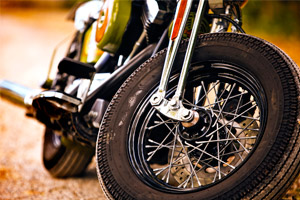 Motorcyclists have less room for error than car drivers. They lack the stability, the protective cage, the crumple zones, the seat belts and air bags enjoyed by operators of four-wheeled vehicles. Unlike motorcyclists, car drivers wearing seat belts aren't ejected from their vehicles in accidents.
Motorcyclists have less room for error than car drivers. They lack the stability, the protective cage, the crumple zones, the seat belts and air bags enjoyed by operators of four-wheeled vehicles. Unlike motorcyclists, car drivers wearing seat belts aren't ejected from their vehicles in accidents.
This is why dangerous riding habits are so important to identify and fix. Bad habits are dangerous practices that are unthinkingly carried out with no appreciation of the risk. Like adding that extra sugar to your coffee, they are mindless responses to familiar circumstances. The first step in fixing bad habits is identifying them. If any of the following sound familiar, take steps now to fix them.
Riding Too Fast in Uncertain Situations
Assuming ideal road conditions when going around blind corners is an accident waiting to happen. Up until now, you've never encountered a deer, a stalled car, road debris or some other hazard as you raced through those corners. However, past experience is no guarantee that you won't encounter a hazard the next time.
Assuming That Others See You
In the world of driving, the motorcyclist is the odd man out. Motorcycles look different because they're small and less visible. Their tremendous acceleration compared to other vehicles means that other drivers on the road don't expect this and may accidentally cut you off. Car drivers are programmed to mostly look out for other four-wheeled vehicles.
Motorcycles also have a thin profile when looking at them head on. This reduces their visibility and means they're less noticeable in very busy traffic situations. The thin profile makes it more difficult to judge their oncoming speed, which is one reason why motorists cut them off at intersections.
Riding With Your Eyes Too Low
Road awareness shouldn't end at the rear bumper of the car ahead of you. Sometimes this habit of fixating on the near distance is cultivated from tailgating where you have little choice but to focus your attention on the tail lights of the car in front. If you increase your following distance, you'll be able to look further down the road. This allows you to plan your lane changes better and gives you more time to react to an emergency.
Failure to Adjust to Wet Weather
Motorcycles are less stable than four-wheeled vehicles. In dry pavement conditions, two wheels have many advantages. However when the pavement is wet, riding becomes precarious. After a rain when the road is partially dried, the odd wet road section can take the rider by surprise.
Improve your riding proficiency and safety by acknowledging and fixing dangerous riding habits. It means you'll have more years of riding ahead of you and may even mean lower motorcycle insurance rates.
Your safety is our priority. Call Auto Insurance Express at (417) 206-3733 for more information on Springfield MO motorcycle insurance.